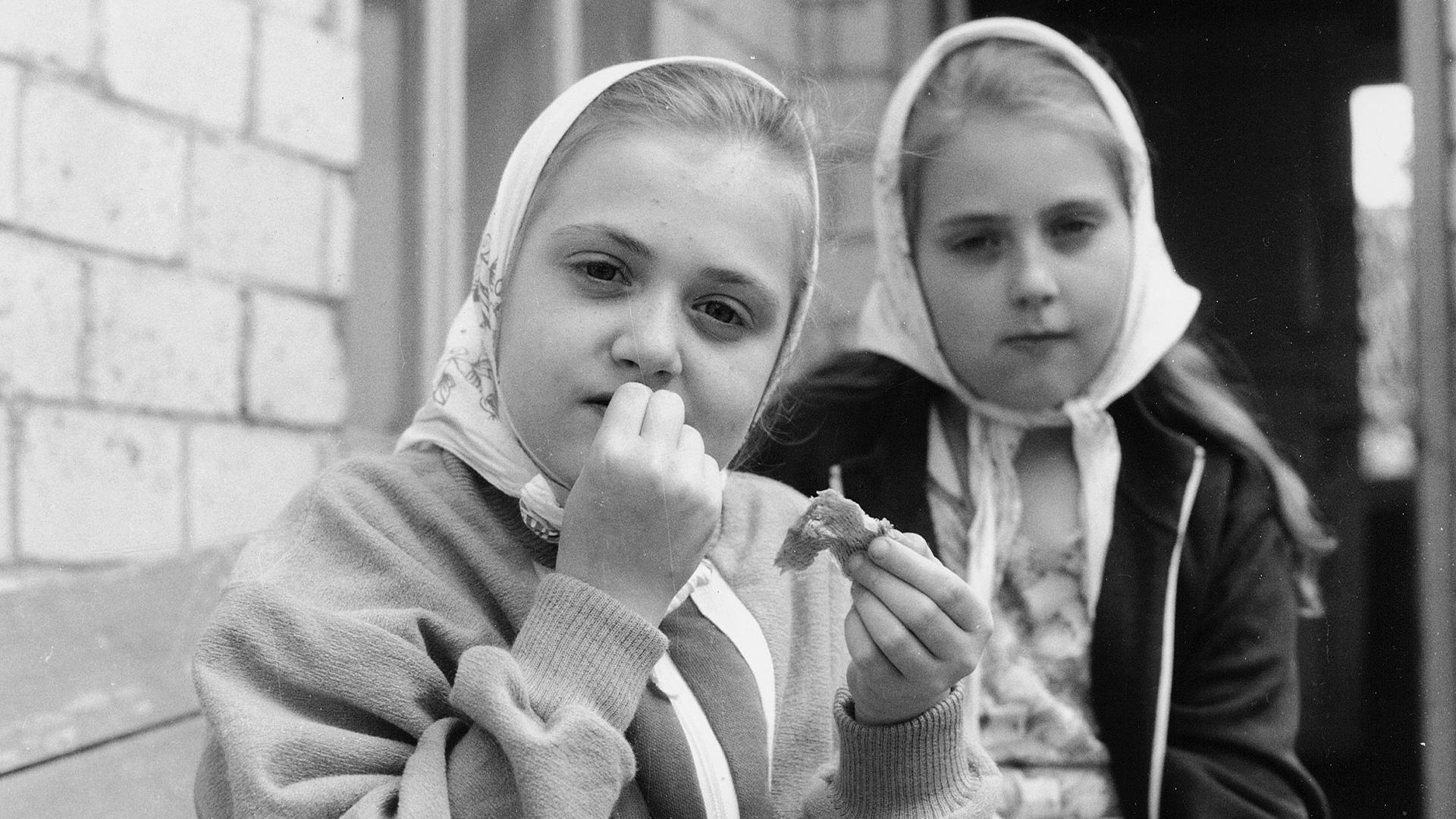
12-vuotiaan, pienikokoisen Tanjuskan kasvot ovat suurisilmäiset ja tutkimattomat kuin ikonin. Hänen kotinsa on Valko-Venäjällä, mutta hän asuu isänsä kanssa Viron ja Venäjän rajalla Vasknarvan kansanluostarissa, ortodoksisessa yhteisössä. Kauas kotoa äidin ja pikkusiskon luota Tanjuska on päätynyt siksi, että täällä yhteisön johtajan, ankaran Isä Vasilin, on määrä manata hänestä riivaajat.
Vanhemmat kertovat yrittäneensä saada apua oudosti oireilleelle, välillä syömisenkin lopettaneelle tyttärelleen niin lääkäristä, kansanparantajilta kuin kirkostakin. ”On niin monia selityksiä. Voi Luoja, ketä pitäisi kuunnella?” äiti tuskailee. Mielisairaalassa Minskissä Tanjuskan diagnoosiksi kerrotaan skitsofrenia. Katsoja vakuuttuu paitsi tytön avun tarpeesta myös siitä, ettei vankilamainen luostarielämä suljettujen muurien takana – päivittäisten manaussessioiden ja vyöllä kurittamisen armoilla – ainakaan edistä Tanjuskan henkistä hyvinvointia.
Pirjo Honkasalon Pyhän ja pahan trilogian (myös Mysterion, 1991 ja Atman, 1996) keskimmäinen osa on häiritsevää, osittain järkyttävääkin katsottavaa. Samalla se on vaikuttavan elokuvallinen kurkistus mielenmaisemaan, jossa vain usko Jumalaan voi auttaa järkkynyttä. Tanjuskaa itseään kuullaan lopun tulkinnanvaraisessa lyhytmonologissa.
Suvi Heino
-----------------
Little 12-year-old Tanjuska has such large eyes and an inscrutable expression, that she resembles an icon. Her real home is in Belarus, but she lives with her father in the Vasknarva Abbey, an orthodox community at the border of Estonia and Russia. Tanjuska is far from her home, mother and sister, as the leader of the community, Father Vasili, means to exorcise her of her demons.
The parents describe their attempts to get help for their strangely symptomatic daughter, who even sometimes stops eating, from doctors, healers and the Church. “There are so many opinions. Lord, who should we listen to?” agonizes her mother. At the asylum in Minsk, Tanjuska is diagnosed with schizophrenia. The audience is convinced not only of the girl’s need for help, but also that the prison-like life behind the closed walls of the Monastery – daily exorcism sessions and discipline by the way of a belt – will in no way help Tanjuska’s mental wellbeing.
The second part of Pirjo Honkasalo’s Trilogy of the Sacred and the Satanic (encompassing also the 1991 Mysterion, and 1996 Atman) is disturbing, and sometimes shocking to watch. At the same time, it is an impressive cinematic glimpse into a mindscape where only faith in God can heal one’s struggles. Tanjuska herself ends the film with a short monologue, which remains open for interpretation.
Suvi Heino (translated by Claire Delhom)
- Year1993
- Runtime82 minutes
- LanguageRussian, Finnish
- CountryFinland, Sweden
- RatingK12
- NoteEnglanninkieliset tekstitykset / English subtitles
- DirectorPirjo Honkasalo
- ProducerPirjo Honkasalo
- CinematographerPirjo Honkasalo
- EditorPirjo Honkasalo
- ComposerHenry Purcell, Matti Bergström, Pirjo Bergström, The Sixth Floor Ensemble
- Sound DesignMartti Turunen
12-vuotiaan, pienikokoisen Tanjuskan kasvot ovat suurisilmäiset ja tutkimattomat kuin ikonin. Hänen kotinsa on Valko-Venäjällä, mutta hän asuu isänsä kanssa Viron ja Venäjän rajalla Vasknarvan kansanluostarissa, ortodoksisessa yhteisössä. Kauas kotoa äidin ja pikkusiskon luota Tanjuska on päätynyt siksi, että täällä yhteisön johtajan, ankaran Isä Vasilin, on määrä manata hänestä riivaajat.
Vanhemmat kertovat yrittäneensä saada apua oudosti oireilleelle, välillä syömisenkin lopettaneelle tyttärelleen niin lääkäristä, kansanparantajilta kuin kirkostakin. ”On niin monia selityksiä. Voi Luoja, ketä pitäisi kuunnella?” äiti tuskailee. Mielisairaalassa Minskissä Tanjuskan diagnoosiksi kerrotaan skitsofrenia. Katsoja vakuuttuu paitsi tytön avun tarpeesta myös siitä, ettei vankilamainen luostarielämä suljettujen muurien takana – päivittäisten manaussessioiden ja vyöllä kurittamisen armoilla – ainakaan edistä Tanjuskan henkistä hyvinvointia.
Pirjo Honkasalon Pyhän ja pahan trilogian (myös Mysterion, 1991 ja Atman, 1996) keskimmäinen osa on häiritsevää, osittain järkyttävääkin katsottavaa. Samalla se on vaikuttavan elokuvallinen kurkistus mielenmaisemaan, jossa vain usko Jumalaan voi auttaa järkkynyttä. Tanjuskaa itseään kuullaan lopun tulkinnanvaraisessa lyhytmonologissa.
Suvi Heino
-----------------
Little 12-year-old Tanjuska has such large eyes and an inscrutable expression, that she resembles an icon. Her real home is in Belarus, but she lives with her father in the Vasknarva Abbey, an orthodox community at the border of Estonia and Russia. Tanjuska is far from her home, mother and sister, as the leader of the community, Father Vasili, means to exorcise her of her demons.
The parents describe their attempts to get help for their strangely symptomatic daughter, who even sometimes stops eating, from doctors, healers and the Church. “There are so many opinions. Lord, who should we listen to?” agonizes her mother. At the asylum in Minsk, Tanjuska is diagnosed with schizophrenia. The audience is convinced not only of the girl’s need for help, but also that the prison-like life behind the closed walls of the Monastery – daily exorcism sessions and discipline by the way of a belt – will in no way help Tanjuska’s mental wellbeing.
The second part of Pirjo Honkasalo’s Trilogy of the Sacred and the Satanic (encompassing also the 1991 Mysterion, and 1996 Atman) is disturbing, and sometimes shocking to watch. At the same time, it is an impressive cinematic glimpse into a mindscape where only faith in God can heal one’s struggles. Tanjuska herself ends the film with a short monologue, which remains open for interpretation.
Suvi Heino (translated by Claire Delhom)
- Year1993
- Runtime82 minutes
- LanguageRussian, Finnish
- CountryFinland, Sweden
- RatingK12
- NoteEnglanninkieliset tekstitykset / English subtitles
- DirectorPirjo Honkasalo
- ProducerPirjo Honkasalo
- CinematographerPirjo Honkasalo
- EditorPirjo Honkasalo
- ComposerHenry Purcell, Matti Bergström, Pirjo Bergström, The Sixth Floor Ensemble
- Sound DesignMartti Turunen
